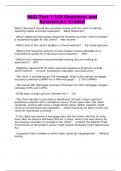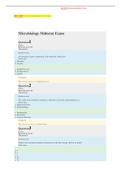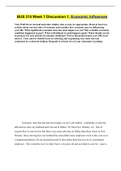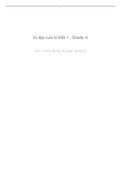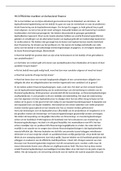Samenvatting GGZ2029
Geschreven in academisch jaar 2021-2022
,Problem 1 – What is addiction?
1. What is addiction? Definition, characteristics, examples?
Drug use= intentional ingestion of a drug
Drug abuse/misuse/problematic use= repeated use of a drug despite negative
consequences or excessive, inappropriate use
Drug dependence/addiction= chronic misuse characterized by compulsive drug seeking
and use despite harmful consequences
Addicts= lay terminology for individuals suffering from drug or alcohol dependence
Different definitions addiction:
Addiction is compulsive need for and use of a habit-forming substance. It is accepted as
a mental illness in the diagnostic nomenclature and results in substantial health, social
and economic problems. It is multifactorally determined, with substantial genetic
influence. The development of addictions is also influenced by environmental factors, and
an interplay between the two. It is characterized by tolerance and well-defined
physiological symptoms upon withdrawal.
Addiction is a strong and habitual want that significantly reduces control and leads to
significant harm. Control and harm come in degrees, addicts have some control over their
choices and actions, but they do not have full or normal control; and hence they have
less control than non-addicts
Defenition WHO: repeated use of a psychoactive substance(s) to the extent that the
user
- is periodically or chronically intoxicated
- shows a compulsion to take the preferred substance(s)
- has great difficulty in voluntarily stopping substance use
- exhibits determination to obtain psychoactive substances
tolerance is prominent and a withdrawal syndrome frequently occurs when substance use
is interrupted. The life of an addict is dominated by substance use to the exclusion of all
other activities and responsibilities.
Central parts in definition addiction:
- Addictive substances
o Psycholeptica suppress CNS (i.e. alcohol, GHB, opiates)
o Psychoanaleptica stimulate CNS (i.e. nicotine, coffee, cocaine, XTC)
o Psychodysleptica causes hallucinations (i.e. LSD, paddo’s, cannabis)
- Getting high
- Severe negative consequences
o Individual
o social
- Compulsion
- Loss of control unable to stop
There are still quite some debates regarding addiction:
- Is addiction a disease?
- Are addicts morally or legally responsible
- Which drug users should you include in experimental studies of addictions
- No consensus on the definition of addiction
, Addiction takes on many forms. The most famous substances to be addicted to includes
heroin, cocaine, morhphine, amphetamines etc. but people can also be addicted to legal
drugs like alcohol, nicotine, caffeine and prescribed medications. But people can also be
addicted to non-substance related behaviors like gambling, sex, work, food, shopping
and internet surfing/gaming.
Substance use also differs with respect to the health risks, also the existence and nature
of withdrawal symptoms varies across kind of substance and individual person. And there
is a variation in who gets addicted, it occurs across levels of SES, intelligence and
education but rates of addiction are positively correlated with low SES, low IQ,
adolescence and early adulthood, childhood abuse, stress, psychiatric disorders and
religion.
Also the motivation for drug use varies. These variation issues a challenge for the
definition of addiction. A lot of definitions for addiction are very vague and loose so we
need one that is more precise.
Withdrawal symptoms can also vary a lot e.g.:
- Heroin bad flue
- Cocaine depression, with loss of energy and interest
- Alcohol (most severe) hallucinations, delirium tremens and death
Addiction is positively correlated with low SES, low IQ, adolescence and early adulthood,
childhood abuse, stress, psychiatric disorders (specifically personality disorders) and
religion
2. DSM-V criteria for diagnosis?
(verywellmind.com)
There are 2 groups of substance-related disorders in the DSM-V:
- substance-use disorders = patterns of symptoms resulting from the use of a
substance that you continue to take, despite experiencing problems as a result
- substance-induced disorders = including intoxication, withdrawal and other
substande/medication-induced mental disorders are detailed alongside substance
use disorders
Criteria for substance-use disorders:
1) taking the substance in larger amounts or for longer than you’re meant to
2) wanting to cut down or stop using the substance but not managing to
3) spending a lot of time getting, using, or recovering from use of the substance
4) cravings and urges to use the substance
5) not managing to do what you should do at work, home, or school because of
substance use
6) continuing to use, even when it causes problems in relationships
7) giving up important social, occupational, or recreational activities because of
substance use
8) using substances again and again, even when it puts you in danger
9) continuing to use, even when you know you have a physical of psychological
problem that could have been caused or made worse by the substance
10) needing more of the substance to get the effect you want (tolerance)
11) development of withdrawal symptoms, which can be relieved by taking more of
the substance
, (Hasin et. Al.)
There is a diagnostic threshold of 2 or more criteria and the severity is represented by the
number of criteria that someone abides.
- 2 to 3 criteria= mild
- 4 to 5 criteria= moderate
- 6 or more= severe
3. Differences in criteria DSM-V and DSM-IV for addiction?
(Hasin et. Al.)
In the DSM-IV there were 2 separate sets of criteria for substance abuse and substance
dependence, in the DSM-V these were combined. In DSM-IV it also placed dependency
higher in the hierarchy of problematicness.
In the DSM-V there were 2 criteria dropped:
- Legal problems: there was a very low prevalence of this in adults with substance
abuse
- Tolerance: not unique as a criteria, it was also enough to diagnose with the other
criteria
In the DSM-V there was 1 criteria added:
- Craving/ a strong desire or urge to use the substance
Differences in specifiers DSM-V
- Psychological specifier was eliminated
- Different time frames for course were made:
o Early remission: >3 months but <12 months without meeting criteria except
for craving
o Sustained remission: >12 months without meeting criteria other than craving
- Substance.medication-induced mental disorders were added to each separate mental
disorder
4. Is addiction always substance related?
No it can be related to any excessive form of behavior.
Non-substance-related disorders: addictive disorders that do not involve ingestion of a
psychoactive substance. This category is referred to as behavioral addiction. The only
condition that is currently included in this category is gambling disorder, including internet
Geschreven in academisch jaar 2021-2022
,Problem 1 – What is addiction?
1. What is addiction? Definition, characteristics, examples?
Drug use= intentional ingestion of a drug
Drug abuse/misuse/problematic use= repeated use of a drug despite negative
consequences or excessive, inappropriate use
Drug dependence/addiction= chronic misuse characterized by compulsive drug seeking
and use despite harmful consequences
Addicts= lay terminology for individuals suffering from drug or alcohol dependence
Different definitions addiction:
Addiction is compulsive need for and use of a habit-forming substance. It is accepted as
a mental illness in the diagnostic nomenclature and results in substantial health, social
and economic problems. It is multifactorally determined, with substantial genetic
influence. The development of addictions is also influenced by environmental factors, and
an interplay between the two. It is characterized by tolerance and well-defined
physiological symptoms upon withdrawal.
Addiction is a strong and habitual want that significantly reduces control and leads to
significant harm. Control and harm come in degrees, addicts have some control over their
choices and actions, but they do not have full or normal control; and hence they have
less control than non-addicts
Defenition WHO: repeated use of a psychoactive substance(s) to the extent that the
user
- is periodically or chronically intoxicated
- shows a compulsion to take the preferred substance(s)
- has great difficulty in voluntarily stopping substance use
- exhibits determination to obtain psychoactive substances
tolerance is prominent and a withdrawal syndrome frequently occurs when substance use
is interrupted. The life of an addict is dominated by substance use to the exclusion of all
other activities and responsibilities.
Central parts in definition addiction:
- Addictive substances
o Psycholeptica suppress CNS (i.e. alcohol, GHB, opiates)
o Psychoanaleptica stimulate CNS (i.e. nicotine, coffee, cocaine, XTC)
o Psychodysleptica causes hallucinations (i.e. LSD, paddo’s, cannabis)
- Getting high
- Severe negative consequences
o Individual
o social
- Compulsion
- Loss of control unable to stop
There are still quite some debates regarding addiction:
- Is addiction a disease?
- Are addicts morally or legally responsible
- Which drug users should you include in experimental studies of addictions
- No consensus on the definition of addiction
, Addiction takes on many forms. The most famous substances to be addicted to includes
heroin, cocaine, morhphine, amphetamines etc. but people can also be addicted to legal
drugs like alcohol, nicotine, caffeine and prescribed medications. But people can also be
addicted to non-substance related behaviors like gambling, sex, work, food, shopping
and internet surfing/gaming.
Substance use also differs with respect to the health risks, also the existence and nature
of withdrawal symptoms varies across kind of substance and individual person. And there
is a variation in who gets addicted, it occurs across levels of SES, intelligence and
education but rates of addiction are positively correlated with low SES, low IQ,
adolescence and early adulthood, childhood abuse, stress, psychiatric disorders and
religion.
Also the motivation for drug use varies. These variation issues a challenge for the
definition of addiction. A lot of definitions for addiction are very vague and loose so we
need one that is more precise.
Withdrawal symptoms can also vary a lot e.g.:
- Heroin bad flue
- Cocaine depression, with loss of energy and interest
- Alcohol (most severe) hallucinations, delirium tremens and death
Addiction is positively correlated with low SES, low IQ, adolescence and early adulthood,
childhood abuse, stress, psychiatric disorders (specifically personality disorders) and
religion
2. DSM-V criteria for diagnosis?
(verywellmind.com)
There are 2 groups of substance-related disorders in the DSM-V:
- substance-use disorders = patterns of symptoms resulting from the use of a
substance that you continue to take, despite experiencing problems as a result
- substance-induced disorders = including intoxication, withdrawal and other
substande/medication-induced mental disorders are detailed alongside substance
use disorders
Criteria for substance-use disorders:
1) taking the substance in larger amounts or for longer than you’re meant to
2) wanting to cut down or stop using the substance but not managing to
3) spending a lot of time getting, using, or recovering from use of the substance
4) cravings and urges to use the substance
5) not managing to do what you should do at work, home, or school because of
substance use
6) continuing to use, even when it causes problems in relationships
7) giving up important social, occupational, or recreational activities because of
substance use
8) using substances again and again, even when it puts you in danger
9) continuing to use, even when you know you have a physical of psychological
problem that could have been caused or made worse by the substance
10) needing more of the substance to get the effect you want (tolerance)
11) development of withdrawal symptoms, which can be relieved by taking more of
the substance
, (Hasin et. Al.)
There is a diagnostic threshold of 2 or more criteria and the severity is represented by the
number of criteria that someone abides.
- 2 to 3 criteria= mild
- 4 to 5 criteria= moderate
- 6 or more= severe
3. Differences in criteria DSM-V and DSM-IV for addiction?
(Hasin et. Al.)
In the DSM-IV there were 2 separate sets of criteria for substance abuse and substance
dependence, in the DSM-V these were combined. In DSM-IV it also placed dependency
higher in the hierarchy of problematicness.
In the DSM-V there were 2 criteria dropped:
- Legal problems: there was a very low prevalence of this in adults with substance
abuse
- Tolerance: not unique as a criteria, it was also enough to diagnose with the other
criteria
In the DSM-V there was 1 criteria added:
- Craving/ a strong desire or urge to use the substance
Differences in specifiers DSM-V
- Psychological specifier was eliminated
- Different time frames for course were made:
o Early remission: >3 months but <12 months without meeting criteria except
for craving
o Sustained remission: >12 months without meeting criteria other than craving
- Substance.medication-induced mental disorders were added to each separate mental
disorder
4. Is addiction always substance related?
No it can be related to any excessive form of behavior.
Non-substance-related disorders: addictive disorders that do not involve ingestion of a
psychoactive substance. This category is referred to as behavioral addiction. The only
condition that is currently included in this category is gambling disorder, including internet

